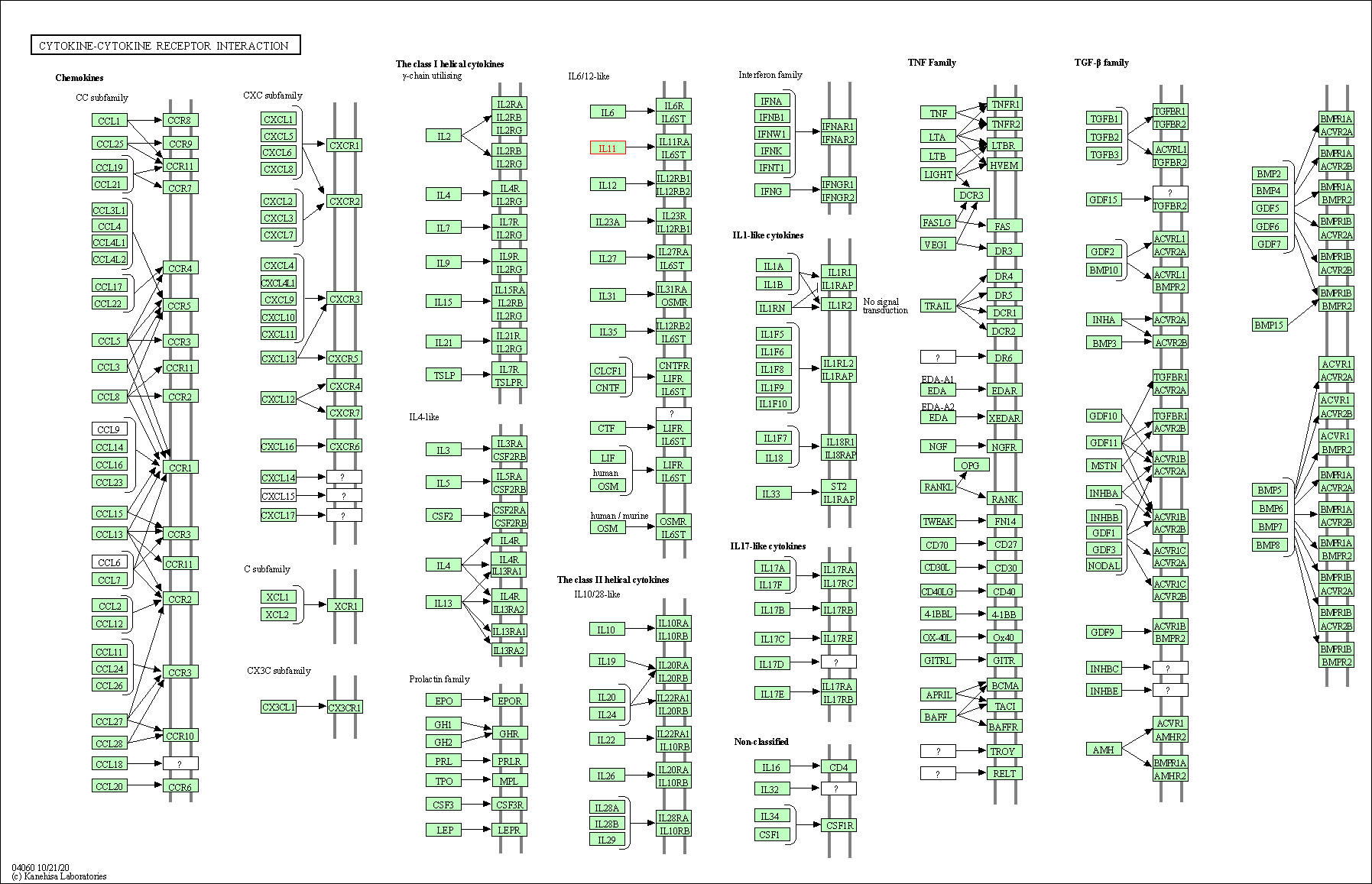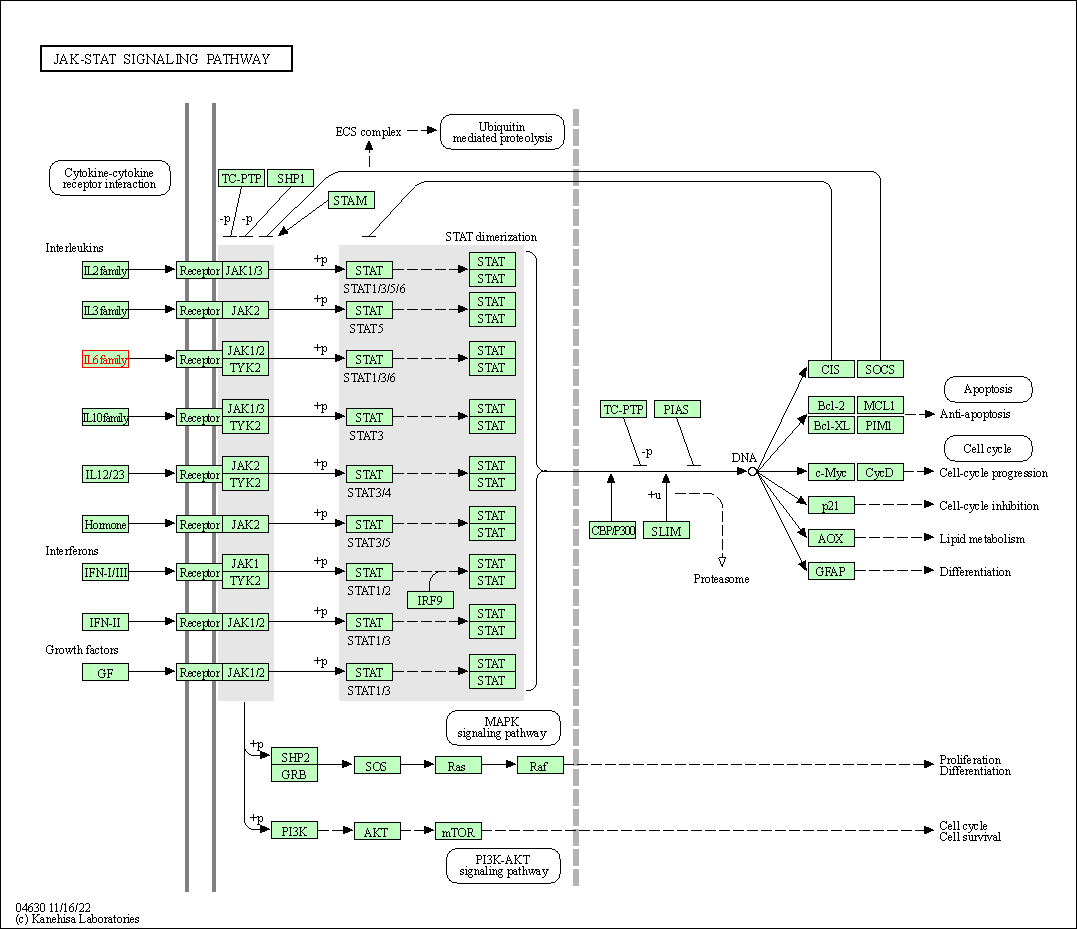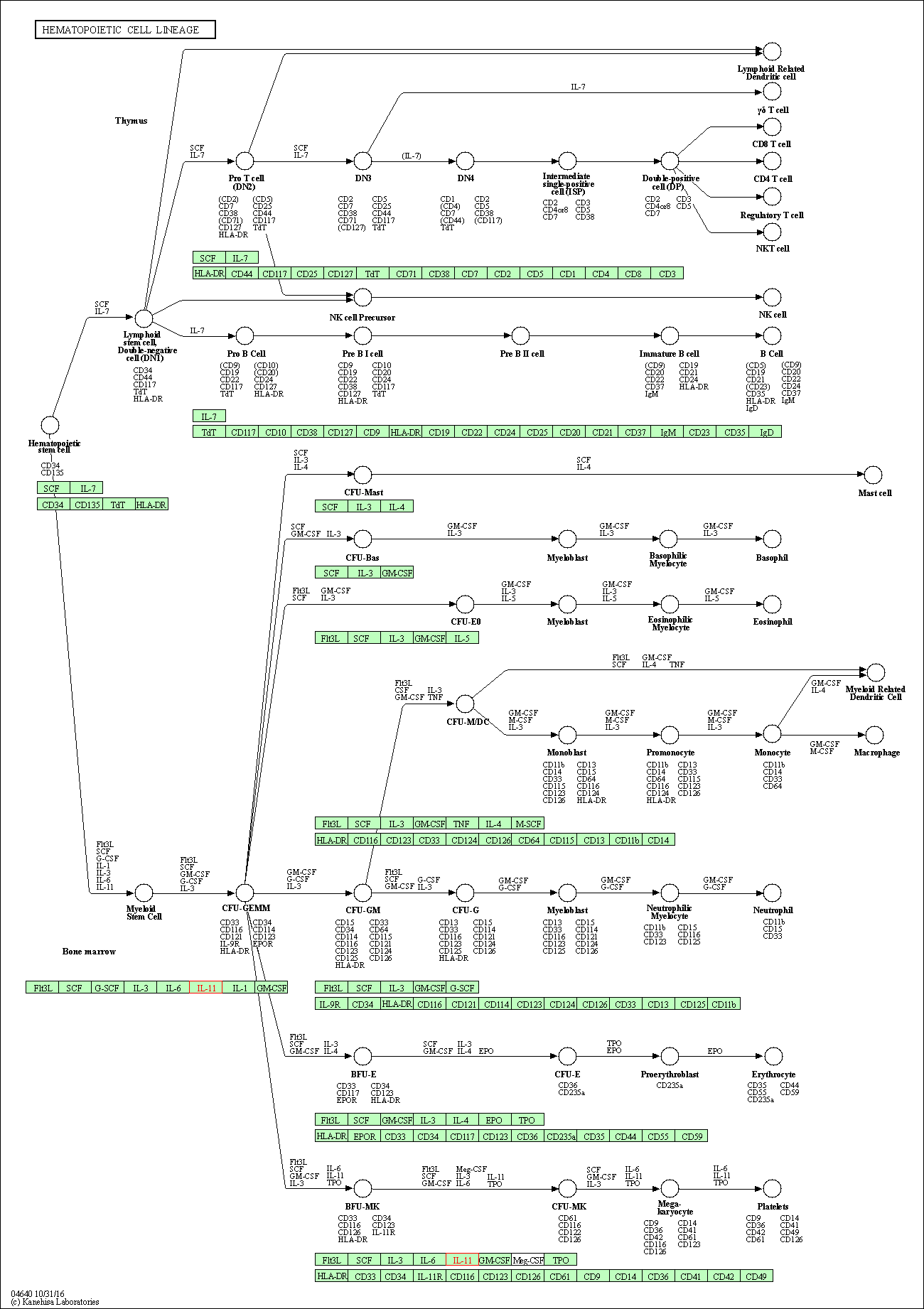Target Information
| Target General Information | Top | |||||
|---|---|---|---|---|---|---|
| Target ID |
T56308
(Former ID: TTDR00519)
|
|||||
| Target Name |
Interleukin-11 (IL11)
|
|||||
| Synonyms |
Oprelvekin; IL-11; Adipogenesis inhibitory factor; AGIF
Click to Show/Hide
|
|||||
| Gene Name |
IL11
|
|||||
| Target Type |
Clinical trial target
|
[1] | ||||
| Disease | [+] 1 Target-related Diseases | + | ||||
| 1 | Thrombocytopenia [ICD-11: 3B64] | |||||
| Function |
Promotes the proliferation of hepatocytes in response to liver damage. Binding to its receptor formed by IL6ST and either IL11RA1 or IL11RA2 activates a signaling cascade that promotes cell proliferation. Signaling leads to the activation of intracellular protein kinases and the phosphorylation of STAT3. Cytokine that stimulates the proliferation of hematopoietic stem cells and megakaryocyte progenitor cells and induces megakaryocyte maturation resulting in increased platelet production.
Click to Show/Hide
|
|||||
| BioChemical Class |
Cytokine: interleukin
|
|||||
| UniProt ID | ||||||
| Sequence |
MNCVCRLVLVVLSLWPDTAVAPGPPPGPPRVSPDPRAELDSTVLLTRSLLADTRQLAAQL
RDKFPADGDHNLDSLPTLAMSAGALGALQLPGVLTRLRADLLSYLRHVQWLRRAGGSSLK TLEPELGTLQARLDRLLRRLQLLMSRLALPQPPPDPPAPPLAPPSSAWGGIRAAHAILGG LHLTLDWAVRGLLLLKTRL Click to Show/Hide
|
|||||
| 3D Structure | Click to Show 3D Structure of This Target | PDB | ||||
| HIT2.0 ID | T12SQ3 | |||||
| Drugs and Modes of Action | Top | |||||
|---|---|---|---|---|---|---|
| Clinical Trial Drug(s) | [+] 1 Clinical Trial Drugs | + | ||||
| 1 | VM-501 | Drug Info | Phase 3 | Thrombocytopenia | [2] | |
| Mode of Action | [+] 1 Modes of Action | + | ||||
| Agonist | [+] 1 Agonist drugs | + | ||||
| 1 | VM-501 | Drug Info | [1] | |||
| Cell-based Target Expression Variations | Top | |||||
|---|---|---|---|---|---|---|
| Cell-based Target Expression Variations | ||||||
| Drug Binding Sites of Target | Top | |||||
|---|---|---|---|---|---|---|
| Ligand Name: Formamide | Ligand Info | |||||
| Structure Description | The crystal structure of human interleukin-11 | PDB:4MHL | ||||
| Method | X-ray diffraction | Resolution | 2.09 Å | Mutation | No | [3] |
| PDB Sequence |
DPRAELDSTV
43 LLTRSLLADT53 RQLAAQLRDK63 FPADGDHNLD73 SLPTLAMSAL85 GALQLPGVLT 95 RLRADLLSYL105 RHVQWLRRAG115 GSSLKTLEPE125 LGTLQARLDR135 LLRRLQLLMS 145 RLALPQDPPA158 PPLAPPSSAW168 GGIRAAHAIL178 GGLHLTLDWA188 VRGLLLLKTR 198 L
|
|||||
|
|
ARG54
3.358
ALA58
2.799
GLN59
4.709
ARG61
2.651
ASP62
3.927
PHE64
4.111
PRO65
2.944
ALA66
3.527
ASP67
3.100
GLY68
4.980
HIS70
2.844
|
|||||
| Click to View More Binding Site Information of This Target with Different Ligands | ||||||
| Different Human System Profiles of Target | Top |
|---|---|
|
Human Similarity Proteins
of target is determined by comparing the sequence similarity of all human proteins with the target based on BLAST. The similarity proteins for a target are defined as the proteins with E-value < 0.005 and outside the protein families of the target.
A target that has fewer human similarity proteins outside its family is commonly regarded to possess a greater capacity to avoid undesired interactions and thus increase the possibility of finding successful drugs
(Brief Bioinform, 21: 649-662, 2020).
Human Pathway Affiliation
of target is determined by the life-essential pathways provided on KEGG database. The target-affiliated pathways were defined based on the following two criteria (a) the pathways of the studied target should be life-essential for both healthy individuals and patients, and (b) the studied target should occupy an upstream position in the pathways and therefore had the ability to regulate biological function.
Targets involved in a fewer pathways have greater likelihood to be successfully developed, while those associated with more human pathways increase the chance of undesirable interferences with other human processes
(Pharmacol Rev, 58: 259-279, 2006).
Biological Network Descriptors
of target is determined based on a human protein-protein interactions (PPI) network consisting of 9,309 proteins and 52,713 PPIs, which were with a high confidence score of ≥ 0.95 collected from STRING database.
The network properties of targets based on protein-protein interactions (PPIs) have been widely adopted for the assessment of target’s druggability. Proteins with high node degree tend to have a high impact on network function through multiple interactions, while proteins with high betweenness centrality are regarded to be central for communication in interaction networks and regulate the flow of signaling information
(Front Pharmacol, 9, 1245, 2018;
Curr Opin Struct Biol. 44:134-142, 2017).
Human Similarity Proteins
Human Pathway Affiliation
Biological Network Descriptors
|
|
|
There is no similarity protein (E value < 0.005) for this target
|
| KEGG Pathway | Pathway ID | Affiliated Target | Pathway Map |
|---|---|---|---|
| Cytokine-cytokine receptor interaction | hsa04060 | Affiliated Target |

|
| Class: Environmental Information Processing => Signaling molecules and interaction | Pathway Hierarchy | ||
| JAK-STAT signaling pathway | hsa04630 | Affiliated Target |

|
| Class: Environmental Information Processing => Signal transduction | Pathway Hierarchy | ||
| Hematopoietic cell lineage | hsa04640 | Affiliated Target |

|
| Class: Organismal Systems => Immune system | Pathway Hierarchy | ||
| Degree | 3 | Degree centrality | 3.22E-04 | Betweenness centrality | 2.02E-04 |
|---|---|---|---|---|---|
| Closeness centrality | 1.87E-01 | Radiality | 1.32E+01 | Clustering coefficient | 0.00E+00 |
| Neighborhood connectivity | 9.00E+00 | Topological coefficient | 3.64E-01 | Eccentricity | 13 |
| Download | Click to Download the Full PPI Network of This Target | ||||
| Target Regulators | Top | |||||
|---|---|---|---|---|---|---|
| Target-regulating microRNAs | ||||||
| Target Profiles in Patients | Top | |||||
|---|---|---|---|---|---|---|
| Target Expression Profile (TEP) | ||||||
| Target Affiliated Biological Pathways | Top | |||||
|---|---|---|---|---|---|---|
| KEGG Pathway | [+] 4 KEGG Pathways | + | ||||
| 1 | Cytokine-cytokine receptor interaction | |||||
| 2 | Jak-STAT signaling pathway | |||||
| 3 | Hematopoietic cell lineage | |||||
| 4 | Rheumatoid arthritis | |||||
| NetPath Pathway | [+] 1 NetPath Pathways | + | ||||
| 1 | TGF_beta_Receptor Signaling Pathway | |||||
| Panther Pathway | [+] 1 Panther Pathways | + | ||||
| 1 | Interleukin signaling pathway | |||||
| WikiPathways | [+] 4 WikiPathways | + | ||||
| 1 | Cytokines and Inflammatory Response | |||||
| 2 | Differentiation Pathway | |||||
| 3 | Integrated Pancreatic Cancer Pathway | |||||
| 4 | Interleukin-11 Signaling Pathway | |||||
| References | Top | |||||
|---|---|---|---|---|---|---|
| REF 1 | Trusted, scientifically sound profiles of drug programs, clinical trials, safety reports, and company deals, written by scientists. Springer. 2015. Adis Insight (drug id 800033052) | |||||
| REF 2 | Trusted, scientifically sound profiles of drug programs, clinical trials, safety reports, and company deals, written by scientists. Springer. 2015. Adis Insight (drug id 800033052) | |||||
| REF 3 | The structure of human interleukin-11 reveals receptor-binding site features and structural differences from interleukin-6. Acta Crystallogr D Biol Crystallogr. 2014 Sep;70(Pt 9):2277-85. | |||||
If You Find Any Error in Data or Bug in Web Service, Please Kindly Report It to Dr. Zhou and Dr. Zhang.

